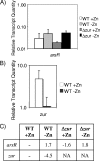Regulation and activity of a zinc uptake regulator, Zur, in Corynebacterium diphtheriae
- PMID: 19074382
- PMCID: PMC2648206
- DOI: 10.1128/JB.01392-08
Regulation and activity of a zinc uptake regulator, Zur, in Corynebacterium diphtheriae
Abstract
Regulation of metal ion homeostasis is essential to bacterial cell survival, and in most species it is controlled by metal-dependent transcriptional regulators. In this study, we describe a Corynebacterium diphtheriae ferric uptake regulator-family protein, Zur, that controls expression of genes involved in zinc uptake. By measuring promoter activities and mRNA levels, we demonstrate that Zur represses transcription of three genes (zrg, cmrA, and troA) in zinc-replete conditions. All three of these genes have similarity to genes involved in zinc uptake. Transcription of zrg and cmrA was also shown to be regulated in response to iron and manganese, respectively, by mechanisms that are independent of Zur. We demonstrate that the activity of the zur promoter is slightly decreased under low zinc conditions in a process that is dependent on Zur itself. This regulation of zur transcription is distinctive and has not yet been described for any other zur. An adjacent gene, predicted to encode a metal-dependent transcriptional regulator in the ArsR/SmtB family, is transcribed from a separate promoter whose activity is unaffected by Zur. A C. diphtheriae zur mutant was more sensitive to peroxide stress, which suggests that zur has a role in protecting the bacterium from oxidative damage. Our studies provide the first evidence of a zinc specific transcriptional regulator in C. diphtheriae and give new insights into the intricate regulatory network responsible for regulating metal ion concentrations in this toxigenic human pathogen.
Figures






Similar articles
-
The Zur regulon of Corynebacterium glutamicum ATCC 13032.BMC Genomics. 2010 Jan 7;11:12. doi: 10.1186/1471-2164-11-12. BMC Genomics. 2010. PMID: 20055984 Free PMC article.
-
Transcriptional regulation by Ferric Uptake Regulator (Fur) in pathogenic bacteria.Front Cell Infect Microbiol. 2013 Oct 2;3:59. doi: 10.3389/fcimb.2013.00059. eCollection 2013. Front Cell Infect Microbiol. 2013. PMID: 24106689 Free PMC article. Review.
-
Identification of zinc and Zur-regulated genes in Corynebacterium diphtheriae.PLoS One. 2019 Aug 27;14(8):e0221711. doi: 10.1371/journal.pone.0221711. eCollection 2019. PLoS One. 2019. PMID: 31454392 Free PMC article.
-
Iron and Zinc Regulate Expression of a Putative ABC Metal Transporter in Corynebacterium diphtheriae.J Bacteriol. 2018 Apr 24;200(10):e00051-18. doi: 10.1128/JB.00051-18. Print 2018 May 15. J Bacteriol. 2018. PMID: 29507090 Free PMC article.
-
Bacterial zinc uptake regulator proteins and their regulons.Biochem Soc Trans. 2018 Aug 20;46(4):983-1001. doi: 10.1042/BST20170228. Epub 2018 Jul 31. Biochem Soc Trans. 2018. PMID: 30065104 Free PMC article. Review.
Cited by
-
The Zur regulon of Corynebacterium glutamicum ATCC 13032.BMC Genomics. 2010 Jan 7;11:12. doi: 10.1186/1471-2164-11-12. BMC Genomics. 2010. PMID: 20055984 Free PMC article.
-
Virulence regulation of Zn2+ uptake system znuABC on mesophilic Aeromonas salmonicida SRW-OG1.Front Vet Sci. 2023 Mar 29;10:1172123. doi: 10.3389/fvets.2023.1172123. eCollection 2023. Front Vet Sci. 2023. PMID: 37065252 Free PMC article.
-
The transcriptional regulator Np20 is the zinc uptake regulator in Pseudomonas aeruginosa.PLoS One. 2013 Sep 23;8(9):e75389. doi: 10.1371/journal.pone.0075389. eCollection 2013. PLoS One. 2013. PMID: 24086521 Free PMC article.
-
Transcriptional regulation by Ferric Uptake Regulator (Fur) in pathogenic bacteria.Front Cell Infect Microbiol. 2013 Oct 2;3:59. doi: 10.3389/fcimb.2013.00059. eCollection 2013. Front Cell Infect Microbiol. 2013. PMID: 24106689 Free PMC article. Review.
-
Heterotrophic nitrification-aerobic denitrification characteristics and zinc-containing wastewater treatment potential of pseudomonas hunanensis SK-4: screening, application, and mechanistic insights.Biodegradation. 2025 Jul 22;36(4):66. doi: 10.1007/s10532-025-10162-0. Biodegradation. 2025. PMID: 40694303
References
-
- Andrews, S. C., A. K. Robinson, and F. Rodriguez-Quinones. 2003. Bacterial iron homeostasis. FEMS Microbiol. Rev. 27215-237. - PubMed
-
- Beard, S. J., M. N. Hughes, and R. K. Poole. 1995. Inhibition of the cytochrome bd-terminated NADH oxidase system in Escherichia coli K-12 by divalent metal cations. FEMS Microbiol. Lett. 131205-210. - PubMed
-
- Bibb, L. A., N. D. King, C. A. Kunkle, and M. P. Schmitt. 2005. Analysis of a heme-dependent signal transduction system in Corynebacterium diphtheriae: deletion of the chrAS genes results in heme sensitivity and diminished heme-dependent activation of the hmuO promoter. Infect. Immun. 737406-7412. - PMC - PubMed
-
- Bray, T. M., and W. J. Bettger. 1990. The physiological role of zinc as an antioxidant. Free Radic Biol. Med. 8281-291. - PubMed
Publication types
MeSH terms
Substances
Grants and funding
LinkOut - more resources
Full Text Sources
Other Literature Sources

